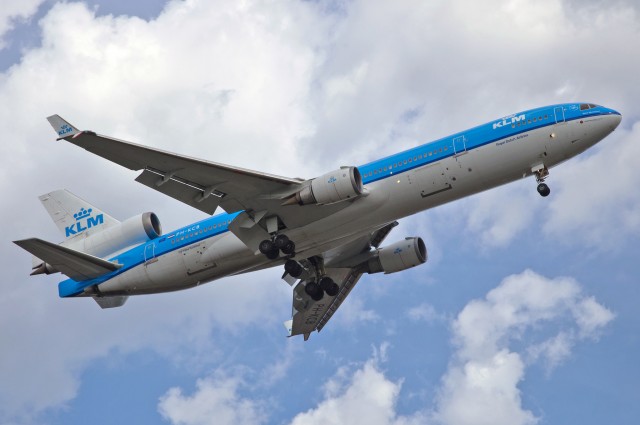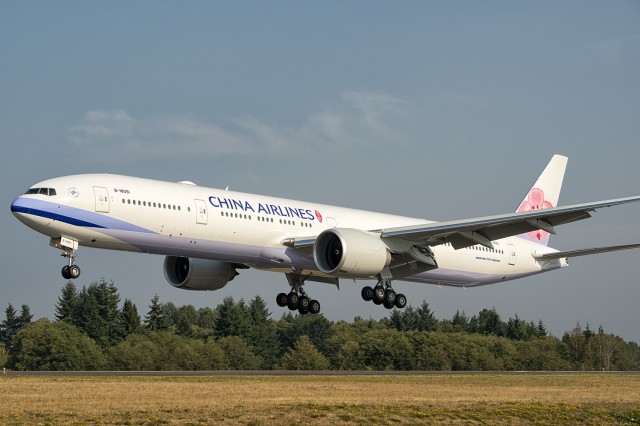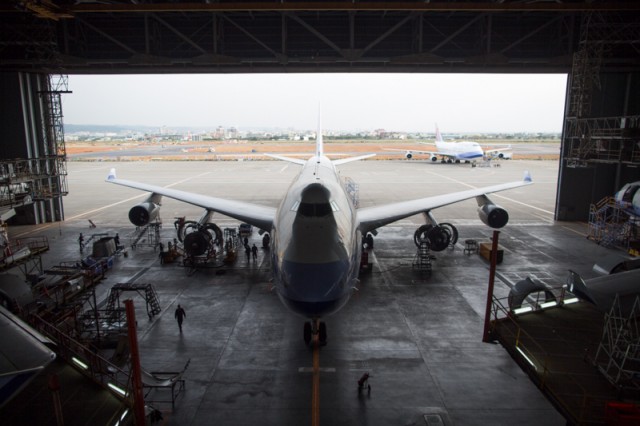
Resting in the hangar, a Boeing 747-400 undergoes a C-check
We recently paid a visit to China Airlines’ (CI) primary maintenance facility, located at Taoyuan International Airport outside Taipei. The monster facility–which held three Boeing 747-400s and an Airbus A340-300 at the time–is able to perform all standard maintenance regimens from A to D checks, as well as landing gear replacement and painting.
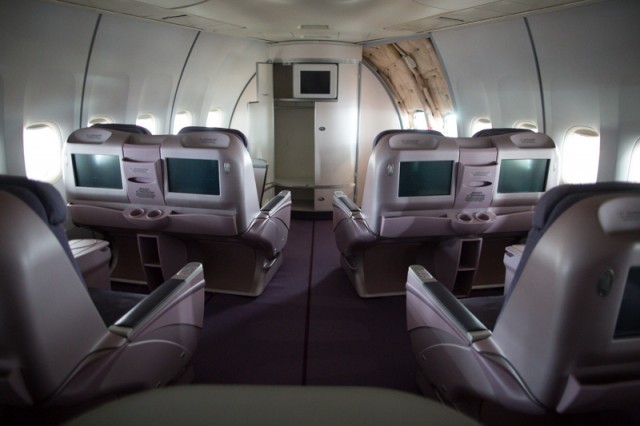
In for a two-week C-check, a Boeing 747 shows signs of care in progress. Each cabin is inspected in detail.
Unfortunately for us (probably good for the airline) their new Boeing 777-300ER wasn’t in the hangar at the time. Being so new, CI is currently only able to complete A-checks on the airplane. It expects to be able to offer up to C-checks by mid-2015, and add service to Panasonic’s IFE system in 2016. Check out our photo gallery and learn more.
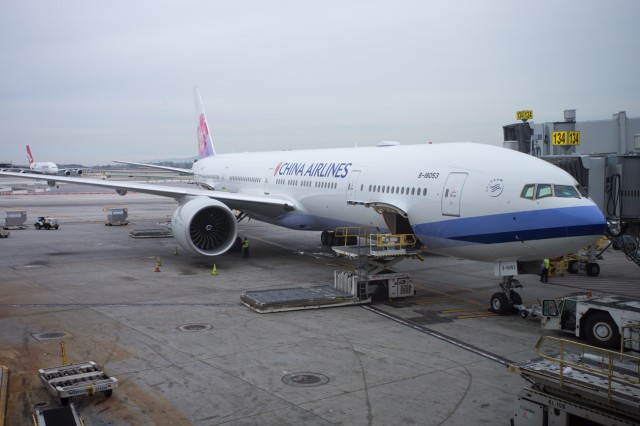
China Airlines’ Boeing 777-300ER – Photo: Jeremy Dwyer-Lindgren
When China Airlines unveiled its new Boeing 777-300ER back in early October of this year, it was clear that this airplane was something special. Photos and videos of the new interioroutfitted with a snazzy new business cabin, homages to Taiwanese culture, and a small libraryquickly made the internet rounds, establishing this plane as the hot new item in the air.
Having seen it myself in Seattle, I knew it had to try it once it was released into the wild. Fast forward two months to last Monday (December 1), when I found myself, ticket in hand, ready to board China Airlines flight 5, service from Los Angeles LAX to Taipei. AirlineReporter/NYCAviation were invited by the airline to sample the carrier’s promising-looking new business class. The formal adventure began in the lounge at Los Angeles International Airport.
China Airlines (CAL), does not have one of its own at the airport, and thus utilizes Korean’s SkyTeam lounge instead. As far as lounges go, this one runs above average, largely thanks to its new-ness and an exterior deck overlooking the main hall. I helped myself to a few finger sandwiches and a beverage while checking email on the free WiFi. Boarding began on time at gate 134. Holding a ticket for the carrier’s premium business class, I boarded quickly via a dedicated jet-way connected to the L1 door.
Those with business tickets are split between two cabins, and today’s seat22Awas in the rear section nestled behind the L2 door. Both cabins are set up in a reverse herringbone style in a 1-2-1 configuration. As boarding continued, cabin crew offered a selection of non-alcoholic pre-flight drinks and hot towels. Bags and personal items slipped easily into overhead bins or into one of three built-in storage areas in the seat. The giant Boeing 777-300ER easily lifted off runway 25R and turned northwest to head up the California coast for the scheduled 14-hour flight to Taipei’s Taoyuan International Airport.
The MD-11 was probably a bad idea. McAir came up with the aircraft because it was a bigger, meaner, DC-10. So much DC-10 that there originally was not going to be an MD-11, but a DC-10 stretch. There were two attempts at this aircraft: a DC-10-10 stretched by 40 feet, and a DC-10-30 stretched by 30 feet. Concurrently, McDonnell Douglas (McAir) was concerned about the range of the 747-SP and began work on an ultra-long-range DC-10 Global.
This research lead to an aircraft series called the DC-10 Super 60. The DC-10 Super 60 was going to be a series. A simple stretch, an ultra-long-range variant, and an aircraft optimized for both range and capacity. Unfortunately for McDonnell Douglas, the American Airlines 191 crash happened – summarily executing the DC-10 program. It did not help that there was economic malaise going on at the time, either.
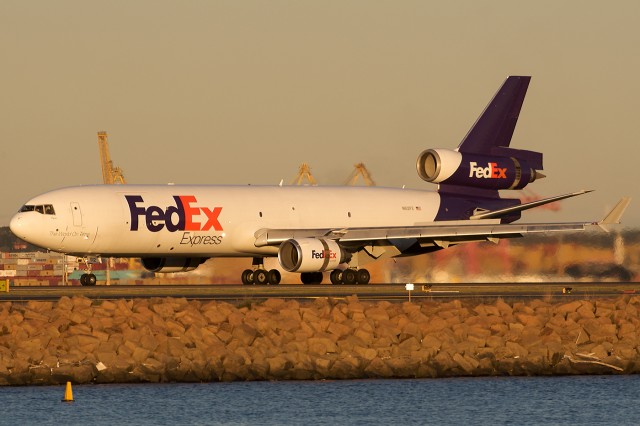
Many MD-11s have been converted to cargo duty. An example arriving at Kingsford-Smith Airport, Sydney. Photo – Bernie Leighton | AirlineReporter
Being the kings of iteration that they were, in 1981 they decided to revive the large trijet research. Leasing a DC-10-10 from Continental, they studied various winglet configurations in conjunction with NASA. For reasons of marketing, this project would be designated the MD-100. This was an interesting project as it actually offered more engine options than the final MD-11, in the form of the Rolls Royce RB.211. By November 1983, it was clear there was no interest in the MD-100. The board shuttered it.
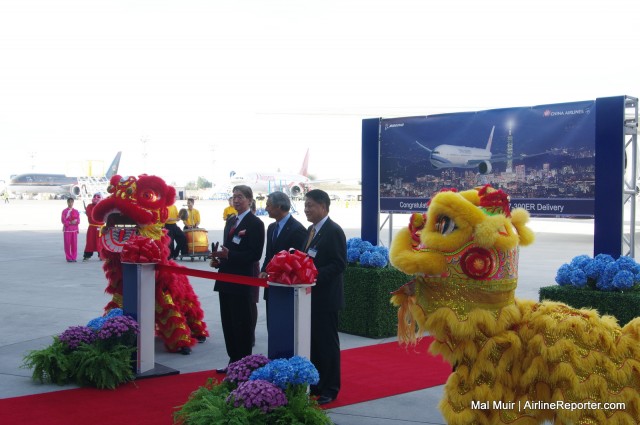
A ribbon cutting at Everett wouldn’t be complete without some dragons, right?
On a sunny Everett friday morning, press, dignitaries, and staff all gathered on the ramp outside the Everett Delivery Center. In front of us was a brand-new Boeing 777-300ER, a giant red ribbon, and two dragons. China Airlines is the newest carrier to receive this twin-jet, and since this was their first of the type, a large ceremony was called for.
China Airlines has been a Boeing customer for over half of a century. Their first Boeing aircraft was the 727, which entered them into the era of flying internationally within southeast Asia. Then, in 1970, they added the Boeing 707, which allowed them to begin transpacific flights to San Francisco.
Soon enough, they were expanding and other North American destinations were added. The airline grew, taking on 747s and, after the years passed, they had a fleet of 13 747-400s flying around the world.
In fact, they were the final customer of the 747-400 in its passenger form, taking delivery of that aircraft (B-18215) on the 26th of April, 2005. Fast-forward nine years later, and the airline is taking their newest Boeing aircraft, the 777-300ER.
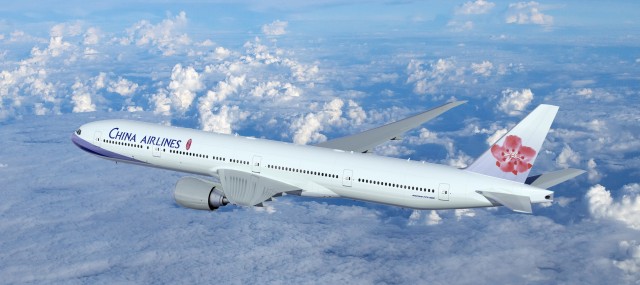
China Airlines Boeing 777-300ER. Image from Boeing.
Last week Boeing managed to book 36 777 orders. While 30 of them are unidentified customers, China Airlines has announced its intention to order six new 777-300ERs worth $2 Billion at list prices along with four options. It is believed that these six aircraft are meant to replace its Airbus A340-300 fleet.
“The introduction of the 777-300ER into our fleet is another important step toward growing our global operations and enhancing our product offering,” said Huang-Hsiang Sun, president of China Airlines. “The 777-300ER sets the standard for twin-aisle airplanes with improved reliability and airplane performance. Our new 777-300ER airplanes will feature new interiors that will enhance the flying experience for our passengers.”
Taiwan’s flag carrier is in the midst of renewing its long-haul fleet and plans to operate the new 777-300ERs on new trans-Pacific flights between North America and Asia. The new airplanes will help the airline enhance its status as the largest airline in Taiwan and a leading global carrier.
“China Airlines has been a valued Boeing customer for more than 50 years and we are honored the airline has chosen the 777-300ER to expand its long-haul fleet,” said Ray Conner, president and CEO of Boeing Commercial Airplanes. “The introduction of the new 777-300ERs will provide China Airlines with new state-of-the-art cabin interiors, while adding improved airplane performance and economics to its long haul fleet.”
The Boeing 777 is the world’s most successful twin-engine, long-haul airplane and it continues to be preferred by airlines around the world, setting a record of 200 airplane orders in 2011. It is 19 percent lighter than its closest competitor, produces 22 percent less carbon dioxide per seat and costs 20 percent less to operate per seat. China Airlines will configure its 777-300ERs to accommodate more than 350 passengers in a three-class configuration and has a maximum range of 7,825 nautical miles (14,490 km).
In addition to the Boeing order for six 777-300ERs, China Airlines also will lease four 777-300ERs from GE Capital Aviation Services (GECAS). China Airlines currently operates 23 Boeing passenger airplanes consisting of 747-400s and 737-800s, and 21 Boeing cargo aircraft consisting of 747-400Fs.
 |
This story written by…Brandon Farris, Correspondent. Brandon is an avid aviation geek based in Seattle. He got started in Photography and Reporting back in 2010. He loves to travel where ever he has to to cover the story and try to get the best darn shot possible.@BrandonsBlog | RightStuffPhotography | Flickr |



